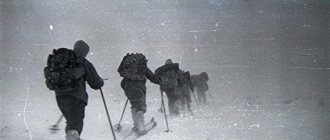Gabrielle was born on August 19, 1883 in the French town of Saumur. All her life this woman made up fables about herself, telling a new version of events in every interview; all her life she passionately loved one man, but never married him. In honor of her birthday, we are talking about interesting facts from the biography of the great Mademoiselle Coco, who changed fashion once and for all.
№ 3
In 1908, Coco met a young Englishman, Arthur Capel, nicknamed Boy. The seasoned heartthrob fell in love with her, and she reciprocated his feelings. Capel advised the girl to open her own hat shop and promised to help with the money. He provided her with everything she needed to start a business, and a couple of years later an atelier with the bold name “Chanel Fashion” appeared in Paris. Chanel's first creation, a minimalist bowler hat, won the hearts of Parisian fashionistas.
The famous boutique at 31 Rue Cambon is still the “heart” of the House of Chanel.
A difficult biography of Coco Chanel: a summary of an eventful life
In the life of this woman there was always enough various events. The most brutal men willingly fulfilled even her slightest desires. She had a lot of love affairs, but none of them led to marriage. But Coco Chanel managed to make a real breakthrough in fashion even without this. It’s not for nothing that they say about artists and other creative people that talent must be hungry: in the case of this beauty, we can say that, burning in emotional and spiritual disappointments, she managed to show millions of women around the world that there are no real limits in which are worth pushing yourself to please anyone.
Interesting
There is a legend that the famous fashion designer suffered from sleepwalking. They say that one day, while staying as usual at the Ritz Hotel in Paris, she got up in the middle of the night and left her room, heading to the wardrobe. There the somnambulist found her bathrobe, took out her sewing supplies and scissors from a special bag, and then cut out a suit. She even attached a towel flower to the new model's lapel. The hotel staff told this story, but it is impossible to find out how true it is.
Briefly about the life of a fashion queen
The future star of fashion shows, the author of the idea of simplifying women's outfits and introducing comfortable, practical accessories, had a far from easy fate. She lost her mother, who never had time to give her her warmth and affection, and her father simply ignored the children, leaving them to be raised by relatives, not caring at all about their future. Despite this, the girl never gave up. In fact, from the age of twelve, Coco Chanel realized that she had to take care of herself. She sang in a bar, made hats and was able to open her own shop on her own.
The Second World War almost destroyed this amazing woman. She entered into suspicious relationships with some high-ranking officials of the Third Reich, for which she was subsequently harshly condemned by society and even almost went to trial. Her entire business had to be curtailed for a while, but this did not become a collapse. It was never possible to break this iron character, hidden in a thin, seemingly airy figure, through troubles and adversity. She became a trendsetter, and even after her death her name remains significant and influential throughout the fashion world.
Family of the future celebrity
Market trader Albert Chanel made a living, looking for the most unexpected goods for resale, such as crafts made from sea fish or frog legs. He lived in a small town with an ancient history called Saumur (French Saumur), picturesquely located on the left bank of the Loire, just where the Thue flows into it. One day, having gone on another of his adventures, on a rural farm he met the rosy and beautiful daughter of a carpenter, Evgenia Zhanna Devol. The young people immediately liked each other, a spark flared up between them. The girl, without hesitation, left her father’s house and followed her lover. History says that they were never married.
On August 19, 1883, in their house above the river, Jeanne gave birth to a girl, who was named with the beautiful name Gabrielle Bonheur (real name Coco Chanel). The unfortunate woman herself, leaving behind a newborn baby, and at the same time her four other young sisters and brothers, died of childbed fever. At first, my father tried to somehow get out, but he realized that in small retail trade he would hardly be able to earn even enough bread for six people. This happened when little Gabrielle was barely a week old.
Childhood and youth
Soon Albert could not stand it anymore and ran away, not caring at all about what would happen to his children. They were left in the care of distant relatives, who also did not want to feed the horde of other people’s offspring. At first they tried to raise children, but soon realized that this was too much responsibility and a burden. It was decided to send the kids to an orphanage, where they spent the next twelve years.
When the children grew up, they could no longer be kept in a charitable institution. The boys were sent as apprentices to artisans so that in the future they could acquire a profession. Gabrielle's two sisters, as well as herself, were assigned to a Catholic monastery in Aubazine, an ancient gloomy town in the Limousin region, now belonging to the department of Corrèze. Here the nuns taught the girls to hold scissors and sew, which became a real outlet for the young beauty.
The years of Coco Chanel's life in the monastery were difficult and full of hardships. Here they fed them from hand to mouth, dressed them in identical dresses, draping fragile figures in cases made of dark gray coarse cloth. Since childhood, Gabi hated these dresses and dreamed of changing everyone into different, normal clothes. In the future, she will do everything possible to completely erase this page not only from her biography, but also from her memory. She will invent a legend that her father sells wine and lives in New York, and will generously “assign” herself the ninety-third year of birth along with the real one.
When the girl turned eighteen, the nuns gave her a letter of recommendation to the owner of a knitwear store in the town of Moulins (Allier department). She settled there for quite a long time. The owners were good people and extremely appreciated the unsurpassed talent of the young dressmaker, who effortlessly coped with even the most difficult tasks in sewing children's and women's clothing.
Cabaret and a new name
It was during this period that Gabrielle found a drinking establishment (cabaret) called “Rotunda”. She had good hearing and a pleasant voice, so after several visits she found herself on the other side of the curtain - she was invited as a singer. This flattered the girl and also forced her to come up with a stage name. In fact, it was given to her by visitors who, after songs called Qui qu'a vu Coco and Ko Ko Ri Ko, simply nicknamed her Coco. This French word has another meaning - kept woman. Perhaps this is just a coincidence, or perhaps Gabi did not disdain to provide the services of a courtesan.
№ 4
In 1916, Gabrielle Coco Chanel began using jersey knitted fabric made from wool, cotton and silk threads for her own line of women's clothing. Before this, jersey was used exclusively for men's underwear.
“Before, jersey was only used for underwear; I honored him by making dresses and suits from him!”
A little later, Chanel introduced the women's suit into fashion, which became a bestseller among women in the 20s. She introduced fashion for jewelry and made artificial pearls more desirable than natural ones. She loved the sun, tan and vests, and she made them relevant. She didn’t want to carry bags in her hands - she gave the world the legendary Chanel 2.55 handbag on a chain.
Gabrielle Coco Chanel
When Gabrielle turned 18, she left the convent and went to Paris. There, she first worked as a saleswoman in a store, and then as a cabaret singer in the Rotunda cafe, where cavalry officers often stayed. During her short musical career, Gabrielle adopted the stage name “Coco”, taken from one of the songs she loved to perform, “Qui Qu'a Vu Coco?” (“Who saw it, Coco”).
Lovers Coco
At this time, she begins relationships with various rich men. Among them are wealthy womanizers Etienne Balsan and Arthur “Boy” Capel. Soon Coco lives with Balzan in his chateau. He pampers her with a luxurious lifestyle, receptions, expensive jewelry and dresses.
Later she meets the love of her life - the Englishman Arthur Kappel, however, who introduces Gabrielle to various theologies and literature. They became lovers and lived together in Paris. She said about Arthur: “he was my father, my brother, my family.”
Their romantic relationship developed very rapidly. Arthur Kappel enjoyed special attention from the ladies. He cheated on her many times while they were together, but Coco claimed that it didn't bother her. Their relationship lasted 9 years, even when he got married. It all ended in 1919 with the death of Arthur Kappel in a car accident.
The loss of a loved one is one of the most difficult moments in Coco's life. Years later, she recalled that “with the loss, Capella lost everything.” Although she had many relationships after this, including with women, she never married, nor did she have such strong feelings for anyone else.
Despite the fact that she was not deprived of male attention and rich lovers, Coco always preferred to be self-sufficient and earn her own living.
Coco Chanel hats
Her passion for fashion began with making hats. She initially made them in Balsan's Parisian apartment, with her other lovers being her first clients. In 1910. She acquires a license for a hat workshop and, thanks to the financial support of both Balsan and Cappel, opens her first boutique on rue Cambon in Paris.
Due to high rents three years later, she had to move her business to Deauville. At this time, she did not have the right to sew clothes, since she did not have the necessary license. But Coco found a solution by starting to create clothes from jersey, a fabric that until then had been used mainly for men's underwear and clothing for the poor.
№ 5
At some point, Arthur Capel will meet the Duchess of Sutherland. He officially proposed his hand and heart to her and received consent. Arthur got married and became a father, but continued to date Coco after the wedding. Chanel could not have children and give her beloved Boy a baby: the reason for this was an abortion, which she had in terrible conditions, which led to irreparable consequences. One day, Gabrielle Chanel, tormented by doubts about the future of her romance with Boy Capel, cut off her luxurious braids in anger, and suddenly realized that short hair that did not cover her long neck suited her very well. And in the spring of 1917, with the help of Gabrielle, a new hairstyle instantly came into fashion. The popular newspaper "Journal" reports that a real revolution has occurred and "the trend of wearing short hair has spread among women in just a few days."
“A woman who changes her haircut is about to change her life,” said Coco Chanel.
Gabrielle Chanel: biography, childhood
She was born on August 19, 1883, in a shelter for the poor in the French town of Saumur. She got the name Gabrielle from the nun nurse at the orphanage hospital. Neither the mother, the daughter of an ordinary worker, nor the father, a traveling merchant, could come up with a name for the newborn. The girl became the second of five children in this family.
When she turned 12, her mother died, exhausted by asthma. The father, who had a passion for the road and drinking, disappeared. The authorities assigned two sons, as abandoned, to someone else’s family, which received benefits for them, and the brothers worked like hell. The three sisters briefly lived with their uncle and aunt, but soon found themselves in a monastery orphanage.
Later, Chanel spoke of those events as unbearable blows for a child’s soul, then she had to deeply feel what it was like to lose everything. This pain gave rise to a hopeless inferiority in the girl, which pushed her to desperately bold actions until her gray hairs.
Uncompromising, arrogant, insolent. Hatred for the idle lifestyle of bohemians and a burning desire to earn money on their own in order to achieve all the benefits of this life. This is all that Coco found in her difficult childhood. And this was useful to her in order to prove to him, who abandoned her to an indifferent man with a mediocre fate, that she exists and she is worthy of love. By the way, they never met their father again.
№ 6
In 1919, Capel died in a car accident. It turns out that Boy was driving with his driver to Cannes, where his wife was waiting for him to celebrate Christmas together. On the way, a tire burst and the car flew into a ditch at full speed. The driver escaped with minor injuries, but Arthur, whose skull was fractured, died on the spot.
“With Capel’s death, I lost everything,” Chanel admitted.
It was at this time that the legendary black dress appeared, which Gabrielle created while in mourning for her lover. And then, at the whim of Chanel, black ceased to be a mourning color and turned into a symbol of elegance.
Circumstances of death and memory of the Queen of Fashion
Gabrielle, who in her old age had already forgotten how difficult it was for her as a child, explained her longevity by the fact that she always slept at night. She preferred to get a good night's sleep before a difficult day, and then do her job efficiently, rather than wander around the house, drinking liters of coffee.
On January tenth, seventy-one, Coco Chanel died quietly in her bed at the Ritz Hotel in Paris, just across the street from her own Fashion House. The cause was a heart attack, quite natural for an eighty-eight-year-old woman.
She was buried in the Lausanne cemetery, where an intricate monument was erected. It is a slab with a name, dates and a cross written at the bottom, and the heads of five lions are carved on top. After her death, only three outfits were found in the old woman’s wardrobe, and this despite the annual income of her empire being one hundred and fifty million.
In memory of the fashion designer
The image of Coco Chanel could not go unnoticed by famous people of art. Her difficult character, willpower and even extreme arrogance - all this served as an impetus for the creation of many theatrical productions. For example, back in 1969, American composer Andre Previn (Previn) created the Broadway musical “Coco.”
Cinematography also got involved. There are a huge number of feature films and documentaries about the couturier. In the eighty-first year of the twentieth century, the drama “Lonely Coco Chanel” was released, starring Marie-France Pisier and Timothy Dalton. In 2008, director Christian Duguay presented a film in which Shirley MacLaine played an outstanding woman. In two thousand and seventeen, a documentary film called “The War for “No 5”” by Stéphane Benhamou also appeared.
What you can learn from Coco
This person with unsurpassed flair and excellent taste has become an example for a huge number of women who want to achieve success in life. She didn't stop for a second, even when fate tried to make her give up and give up. Her work on her own brand stands out as assertive and methodical.
She decided that she would become famous and did everything to achieve this, not succumbing to any dangers. Faith in her strength and extreme determination always led her forward, and she managed to write her name in golden letters in the world history of fashion.
№ 7
In 1921, she released the famous perfume “Chanel No. 5”. The Russian emigrant Ernest Bo worked on the fragrance. These were the first perfumes with a complex aroma that did not even remotely resemble the smell of known flowers. And Chanel argued that a woman who does not wear perfume has no future.
“Perfume is an invisible, but unforgettable, unrivaled fashion accessory. It notifies you of a woman’s appearance and continues to remind you of her when she’s gone...”
Coco Chanel during the war years
In the 20s, Coco began a long affair with the Duke of Westminster-Hugh Grosvenor. It was he who introduced her to the English aristocracy and Churchill himself. The famous Prime Minister was very impressed by this acquaintance and considered her one of the strongest and most intelligent women he had ever met.
The Second World War (1939-1945) found Coco Chanel at the height of her fame, but this period became a black spot in Chanel’s biography.
Despite the fact that she is closing her boutiques, Coco decided not to leave the French capital. Throughout this period, she lived at the Ritz Hotel and had relationships with high-ranking SS military personnel. Rumor has it that she even had an affair with the head of foreign policy intelligence, Walter Schellenberg.
At the end of the war, Coco was arrested by the Committee of Public Morals and accused of collaboration. She was released a few hours later after the personal intervention of Winston Churchill.
Some believe that Coco worked as an agent and was a liaison between British and German intelligence. However, France has not forgiven Chanel, and she is rejected by society.
Post-war fashion
After the war, many new fashion designers begin to appear, some of whom Coco treats with ridicule. About the ladies dressed in Christian Dior's designs, she said: “Look how ridiculous women are in clothes created by a man who does not know women, has never had one, but dreams of being one.”
In the 50s, Coco Chanel returned from her “exile” in Switzerland and after 20 years of calm, in 1954, she presented a new collection of fashionable clothes. Journalists and fashion experts were shocked and outraged. However, it soon turned out that they were deeply mistaken.
№ 10
Coco Chanel worked until her last days. She died of a heart attack at the age of 88 in a suite at the Ritz Hotel, opposite the world-famous House of Chanel. Mademoiselle Coco was convinced that her mission in the fashion world was to free women from tight corsets that make it impossible to breathe and bulky hats that “get in the way of thinking.”
“If you can’t go to the theater in a dress hanging in your closet, then why is it still there? It’s the same about men: if you don’t feel like a beautiful and desirable girl next to a man, surrounded by love and care, then why are you still with him?”
Photo: Getty Images
Brand Coco Chanel
After her death, the Coco Chanel brand experienced some difficulties and came out of the shadows in 1983, when the famous Karl Lagerfeld became the main designer of the fashion house. It is believed that it was he who returned the shine to Chanel. In 2014, the brand was valued at more than $7 billion.
Chanel's life has inspired many biographical publications, plays and films. Among her famous works are the Broadway musical “Coco,” in which Katharine Hepburn plays the role of the designer, and the film “Coco before Chanel” (2009), where Audrey Tautou “turned” into Gabrielle. Coco herself summed up her life and work with the words: “to be irreplaceable, you must always be different.”
Paris
The meeting with Etienne Baysan opened the door to another world. A military man, an aristocrat by birth, he had a huge inheritance and a glorious character. Their relationship began in that very “Rotunda”.
Having moved to his country house, the young provincial girl gained access to social life, but never became Etienne’s legal companion.
When Gabrielle Chanel, whose photo in her youth is presented to your attention in the article, decided to open an atelier, Baysan refused her a loan, but provided her with his Parisian apartment for these purposes.
Despite the warm relationship, Etienne never confessed his love and was not eager to get married. His feelings flared up when his mistress left for another. The other was his closest friend.
View gallery











